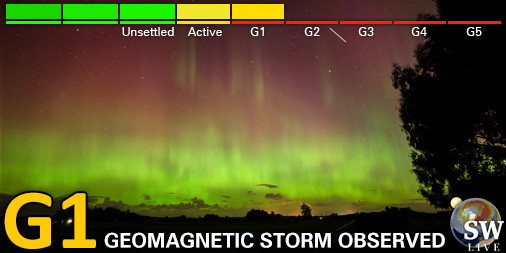Viewing archive of Sunday, 15 February 2015
Daily bulletin on solar and geomagnetic activity from the SIDC
Issued: 2015 Feb 15 1302 UTC
SIDC Forecast
Solar flares
Quiet conditions (<50% probability of C-class flares)
Geomagnetism
Quiet (A<20 and K<4)
Solar protons
Quiet
| 10cm flux | Ap | |
|---|---|---|
| 15 Feb 2015 | 118 | 006 |
| 16 Feb 2015 | 117 | 007 |
| 17 Feb 2015 | 118 | 003 |
Bulletin
Over the past 24 hours there were several B class flares. Most activity occurred in (Active Region) AR 2282 currently located close to the center of the solar disk (N10W10). AR 2283 produced the largest flare, a B9.0 class flare on 2015-Feb-15 peaking at 00:51 UTC. NOAA AR 2281 has moved on to the Western hemisphere limb. NOAA ARs 2282, 2283 and 2284 all appear stable, with small amounts of flux emergence. AR 2283, which emerged near disk center on 2015-Feb-12, has remained small and appears stable, but did produce the largest flare. There is a large filament located between S40W30 and S10W90, however this has remained, and appears, stable. A second less well-defined filament is centered on S20E20, but this also appears stable. Flaring is expected to continue at the B-class level with a possibility of C-class flares. There was a sharp spike in proton numbers at 22:30 UTC on 2015-Feb-14. There were no Earth directed CMEs, but LASCO recorded two CMEs off of the Eastern hemisphere, the first at 22:00 UTC on 2015-Feb-14 and a second at 03:12 UTC on 2015-Feb-15. Both events were small and believed to be back sided. As the source AR rotates into view we may experience more geo-effective activity. The solar wind speed has remained stable over the past 24 hours around 320 km /s, with a small increase over the past 3 hours to around 350 km /s. The total magnetic field has shown a gentle increase over the past 24 hours, increasing from 6 nT to 10 nT. The field showed a sharp drop at around 21:00 UTC on 2015-Feb-14, and then increased again at 01:00 UTC on 2015-Feb-15. The source is believed to be the coronal hole in the Western hemisphere. The Bz has ranged between +6 and -6 nT over the past 24 hours, and also experienced the same drop in field strength as the total field. Geomagnetic conditions were quiet to moderate over the past 24 hours (NOAA Kp 0-2, local K Dourbes 0-3). A large transient coronal hole is currently centered at W55. Solar wind conditions have been quiet, which is expected to persist. Geomagnetic conditions are expected to be quiet to unsettled with an isolated active period possible.
Today's estimated international sunspot number (ISN): 047, based on 13 stations.Solar indices for 14 Feb 2015
| Wolf number Catania | /// |
| 10cm solar flux | 120 |
| AK Chambon La Forêt | 006 |
| AK Wingst | 002 |
| Estimated Ap | 002 |
| Estimated international sunspot number | 038 - Based on 13 stations |
Noticeable events summary
| Day | Begin | Max | End | Loc | Strength | OP | 10cm | Catania/NOAA | Radio burst types | |
|---|---|---|---|---|---|---|---|---|---|---|
| None | ||||||||||
Provided by the Solar Influences Data analysis Center© - SIDC - Processed by SpaceWeatherLive
All times in UTC
Current data suggests there is a moderate possibility for aurora to appear at the following high latitude regions in the near future
Oulu, Rovaniemi, Sodankylä, UtsjokiKirkenes
Arkhangelsk, Murmansk, Vorkuta
Kiruna, Luleå
Current data suggests there is a slight possibility for aurora to appear at the following high latitude regions in the near future
KuopioBergen, Trondheim
Sundsvall, Umeå
Current data suggests there is a slight possibility for aurora to appear at the following middle latitude regions in the near future
TamperePetrozavodsk, Syktyvkar
Latest news
Latest forum messages
Support SpaceWeatherLive.com!
A lot of people come to SpaceWeatherLive to follow the Sun's activity or if there is aurora to be seen, but with more traffic comes higher server costs. Consider a donation if you enjoy SpaceWeatherLive so we can keep the website online!

Latest alerts
13:15 UTC - Geomagnetic activity
Minor G1 geomagnetic storm (Kp5) Threshold Reached: 13:07 UTC
12:33 UTC - Hemispheric Power Index
The OVATION model predicts the Hemispheric Power Index to reach 75GW at 13:21 UTC
00:15 UTC - Geomagnetic activity
Minor G1 geomagnetic storm (Kp5) Threshold Reached: 23:59 UTC
Thursday, 3 April 2025
20:15 UTC - Geomagnetic activity
Minor G1 geomagnetic storm (Kp5) Threshold Reached: 20:02 UTC
13:03 UTC - Hemispheric Power Index
The OVATION model predicts the Hemispheric Power Index to reach 50GW at 13:56 UTC
Space weather facts
| Last X-flare | 2025/03/28 | X1.1 |
| Last M-flare | 2025/04/01 | M2.5 |
| Last geomagnetic storm | 2025/03/27 | Kp5 (G1) |
| Spotless days | |
|---|---|
| Last spotless day | 2022/06/08 |
| Monthly mean Sunspot Number | |
|---|---|
| March 2025 | 134.2 -20.4 |
| April 2025 | 143 +8.8 |
| Last 30 days | 130.4 -16.1 |





